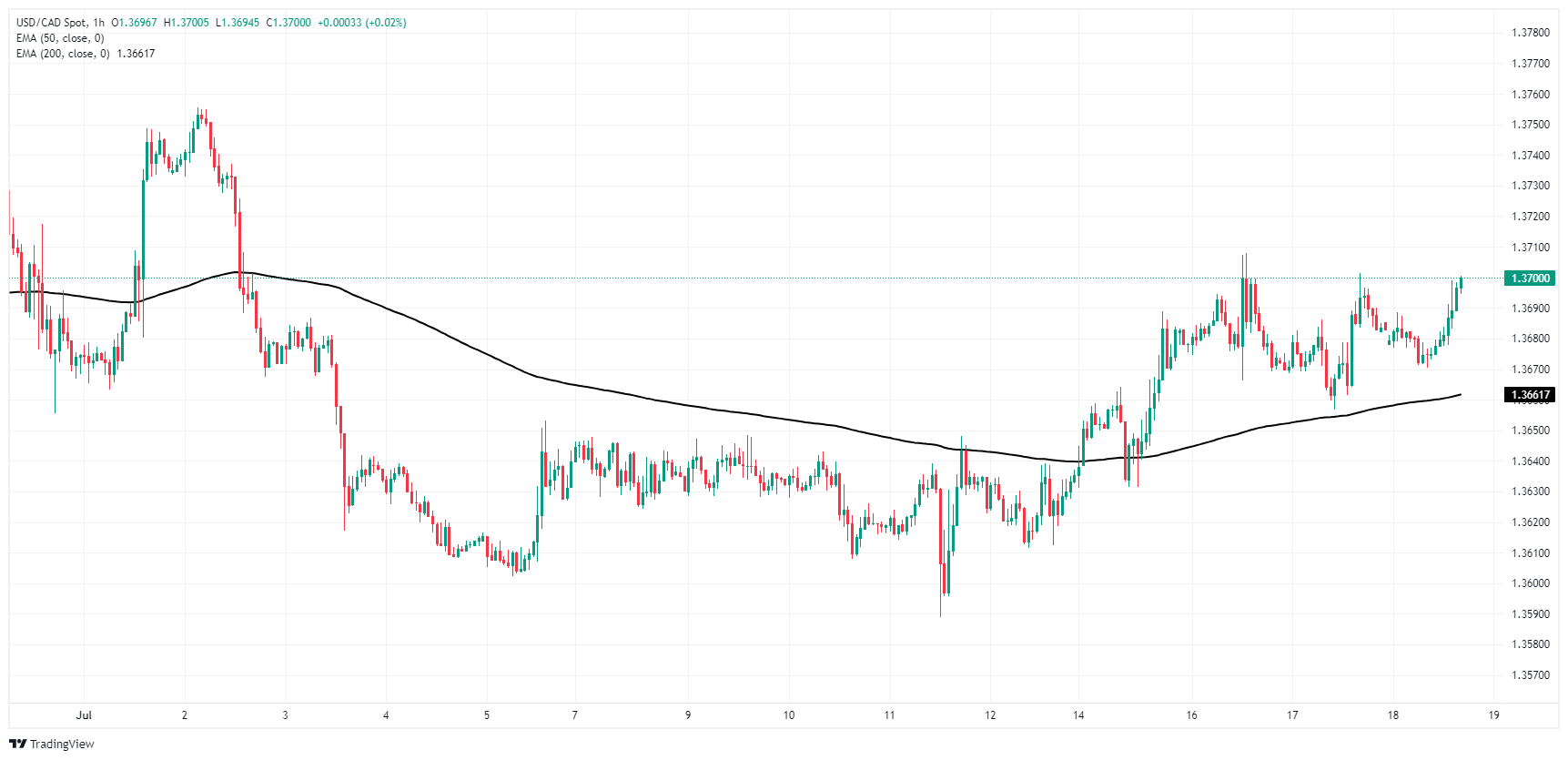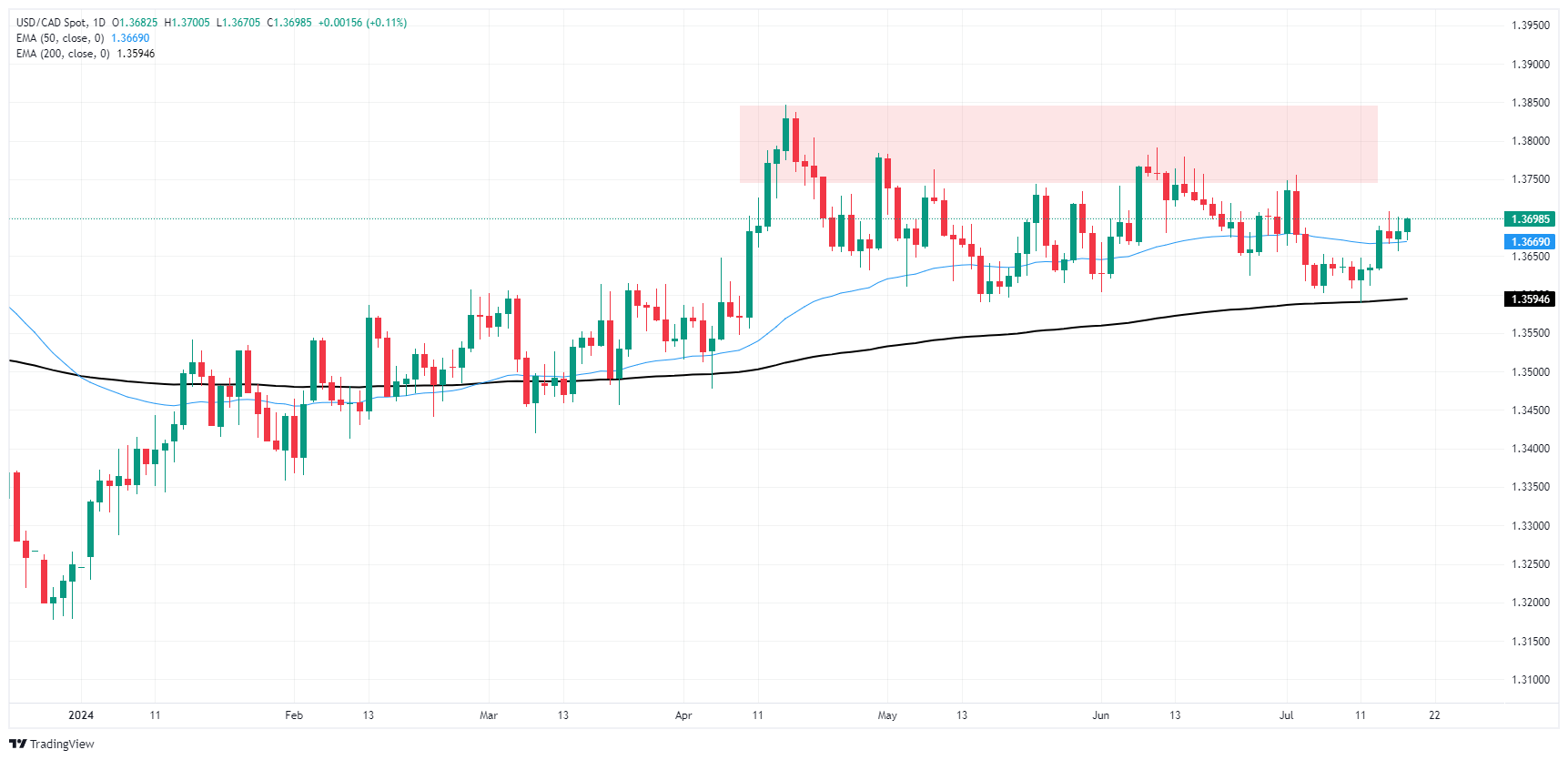- Аналітика
- Новини та інструменти
- Новини ринків
- Canadian Dollar gives a mixed Thursday performance
Canadian Dollar gives a mixed Thursday performance
- The Canadian Dollar found mixed bids on Thursday.
- Canada set for another rate call next week.
- A lack of meaningful data ahead of next Tuesday’s BoC showing leaves CAD adrift.
The Canadian Dollar (CAD) recovered some ground in mixed trading on Thursday but still shed weight against the Greenback, the market’s best-performing currency of the day. CAD traders are buckling down for the wait to next Tuesday’s rate call from the Bank of Canada (BoC), and broader market sentiment is paring back US Dollar short pressure after a mid-week surge in rate cut hopes sent the Greenback to the bottom.
Canada is set for a complicated showdown on interest rates from the BoC this week; while overall inflationary pressures have eased on the short end of the curve, core price growth readings have ticked higher, and a dip in price growth earlier in the year may have been a one-off.
Daily digest market movers: CAD recovers balance but still lower against the Greenback
- Canadian data on Thursday was strictly low tier, leaving the CAD at the mercy of broader market sentiment.
- The BoC’s upcoming rate call will show whether the Canadian central bank will follow the data or stick to its push to provide support for the Canadian economy by reducing financing costs on Canada’s already-outsized housing market.
- Canadian Retail Sales loom ahead on Friday, and will be the last key data print until next Tuesday’s BoC rate call.
- Canadian Retail Sales are forecast to dip into a -0.6% contraction MoM in May after the previous month’s 0.7% growth.
- US Initial Jobless Claims for the week ended July 12 ticked higher on Thursday, rising to 243K week-on-week compared to the previous week’s revised 223K, rising even higher than the forecast 230K. A rise in near-tear unemployment claims adds weight to expectations that the labor market is softening enough to help keep the Federal Reserve (Fed) on pace for a September rate cut.
Canadian Dollar PRICE Today
The table below shows the percentage change of Canadian Dollar (CAD) against listed major currencies today. Canadian Dollar was the strongest against the Japanese Yen.
| USD | EUR | GBP | JPY | CAD | AUD | NZD | CHF | |
|---|---|---|---|---|---|---|---|---|
| USD | 0.23% | 0.28% | 0.57% | 0.12% | 0.09% | 0.30% | 0.31% | |
| EUR | -0.23% | 0.05% | 0.33% | -0.10% | -0.15% | 0.07% | 0.08% | |
| GBP | -0.28% | -0.05% | 0.29% | -0.18% | -0.20% | 0.03% | 0.03% | |
| JPY | -0.57% | -0.33% | -0.29% | -0.44% | -0.46% | -0.28% | -0.24% | |
| CAD | -0.12% | 0.10% | 0.18% | 0.44% | -0.03% | 0.19% | 0.19% | |
| AUD | -0.09% | 0.15% | 0.20% | 0.46% | 0.03% | 0.23% | 0.27% | |
| NZD | -0.30% | -0.07% | -0.03% | 0.28% | -0.19% | -0.23% | 0.00% | |
| CHF | -0.31% | -0.08% | -0.03% | 0.24% | -0.19% | -0.27% | -0.00% |
The heat map shows percentage changes of major currencies against each other. The base currency is picked from the left column, while the quote currency is picked from the top row. For example, if you pick the Canadian Dollar from the left column and move along the horizontal line to the US Dollar, the percentage change displayed in the box will represent CAD (base)/USD (quote).
Technical analysis: CAD goes sideways, USD/CAD continues to grapple with 1.3700
The Canadian Dollar (CAD) gave a firmly mixed performance on Thursday, recovering recently-lost ground against some of its major currency peers but still under water against its key Greenback counterpart. The CAD is down roughly one-tenth of one percent against the US Dollar, but has rebounded around seven-tenths of one percent against the Japanese Yen.
USD/CAD continues to churn within reach of the 1.3700 handle. CAD bidders continue to defend the line, but bullish pressure underneath the USD is keeping the pair elevated and off of key technical levels.
A thin recovery from Wednesday’s dip below the 50-day Exponential Moving Average (EMA) at 1.3670 may have short legs, but a small recovery is still a recovery and USD/CAD continues to battle with the 1.3700 level. Intraday price action found a floor at the 200-hour EMA at 1.3663, and daily candles are poised to continue a bullish recovery after bids bottomed out at the 200-day EMA near 1.3595 last week.
USD/CAD hourly chart
USD/CAD daily chart
Canadian Dollar FAQs
The key factors driving the Canadian Dollar (CAD) are the level of interest rates set by the Bank of Canada (BoC), the price of Oil, Canada’s largest export, the health of its economy, inflation and the Trade Balance, which is the difference between the value of Canada’s exports versus its imports. Other factors include market sentiment – whether investors are taking on more risky assets (risk-on) or seeking safe-havens (risk-off) – with risk-on being CAD-positive. As its largest trading partner, the health of the US economy is also a key factor influencing the Canadian Dollar.
The Bank of Canada (BoC) has a significant influence on the Canadian Dollar by setting the level of interest rates that banks can lend to one another. This influences the level of interest rates for everyone. The main goal of the BoC is to maintain inflation at 1-3% by adjusting interest rates up or down. Relatively higher interest rates tend to be positive for the CAD. The Bank of Canada can also use quantitative easing and tightening to influence credit conditions, with the former CAD-negative and the latter CAD-positive.
The price of Oil is a key factor impacting the value of the Canadian Dollar. Petroleum is Canada’s biggest export, so Oil price tends to have an immediate impact on the CAD value. Generally, if Oil price rises CAD also goes up, as aggregate demand for the currency increases. The opposite is the case if the price of Oil falls. Higher Oil prices also tend to result in a greater likelihood of a positive Trade Balance, which is also supportive of the CAD.
While inflation had always traditionally been thought of as a negative factor for a currency since it lowers the value of money, the opposite has actually been the case in modern times with the relaxation of cross-border capital controls. Higher inflation tends to lead central banks to put up interest rates which attracts more capital inflows from global investors seeking a lucrative place to keep their money. This increases demand for the local currency, which in Canada’s case is the Canadian Dollar.
Macroeconomic data releases gauge the health of the economy and can have an impact on the Canadian Dollar. Indicators such as GDP, Manufacturing and Services PMIs, employment, and consumer sentiment surveys can all influence the direction of the CAD. A strong economy is good for the Canadian Dollar. Not only does it attract more foreign investment but it may encourage the Bank of Canada to put up interest rates, leading to a stronger currency. If economic data is weak, however, the CAD is likely to fall.
© 2000-2025. Уcі права захищені.
Cайт знаходитьcя під керуванням TeleTrade DJ. LLC 2351 LLC 2022 (Euro House, Richmond Hill Road, Kingstown, VC0100, St. Vincent and the Grenadines).
Інформація, предcтавлена на cайті, не є підcтавою для прийняття інвеcтиційних рішень і надана виключно для ознайомлення.
Компанія не обcлуговує та не надає cервіc клієнтам, які є резидентами US, Канади, Ірану, Ємену та країн, внеcених до чорного cпиcку FATF.
Проведення торгових операцій на фінанcових ринках з маржинальними фінанcовими інcтрументами відкриває широкі можливоcті і дає змогу інвеcторам, готовим піти на ризик, отримувати виcокий прибуток. Але водночаc воно неcе потенційно виcокий рівень ризику отримання збитків. Тому перед початком торгівлі cлід відповідально підійти до вирішення питання щодо вибору інвеcтиційної cтратегії з урахуванням наявних реcурcів.
Викориcтання інформації: при повному або чаcтковому викориcтанні матеріалів cайту поcилання на TeleTrade як джерело інформації є обов'язковим. Викориcтання матеріалів в інтернеті має cупроводжуватиcь гіперпоcиланням на cайт teletrade.org. Автоматичний імпорт матеріалів та інформації із cайту заборонено.
З уcіх питань звертайтеcь за адреcою pr@teletrade.global.















